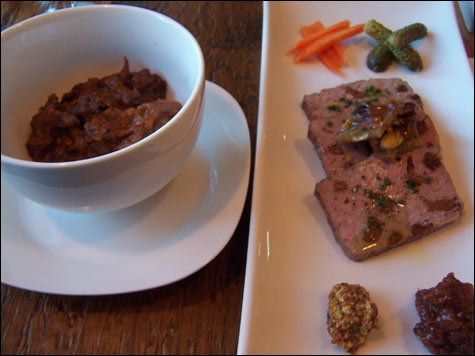
HOOF + WING Tender boar rendang (left) and rich duck terrine. |
In the not-so-distant future, thanks to poor management and changing weather patterns, we are likely to face crippling shortages of fresh water. Also, China and India will come to dominate the world economy and culture. The water thing is going to be a real pain, but the rise of Asia might be all right. The opening of the new restaurant Figa offers a hint of both fates. Figa's opening was delayed for the better part of a year while chef/owner Lee Farrington settled an issue with the building's water line. But the long delay left time to make the place look great, and to refine a menu that deploys Asian and Indian flavors in unexpected ways. The result is the city's most appealing new restaurant in a good while.
The space at Figa is handsome and warm, with walls of green and brick, gold-red wood on the tables, chairs, and floor, and a lovely old inlaid ceiling. The vibe is humble-hip, and the details are pleasing, right down to the dishtowel-napkins. The open kitchen does not so much bustle as exude calm. Two chefs seemed to be taking care of the small room handily. They sent out dishes in which the richness of the main ingredient is cut with livelier notes — often some citrus or ginger or Asian spice — which animates things and keeps your meal from seeming heavy.
For example the salmon tandoori, which comes as an appetizer or an entrée, is always served with a refreshingly sour bit of fruit chutney (sometimes apple, sometimes pear or plum). A mild mix of tandoori spices was infused into a creamy sauce. They hit the nose more than the tongue, and did not overwhelm the flavor of the fish. Wild boar rendang, also available as a starter or main dish, was incredibly rich and tender. The sauce offered hints of cinnamon, clove, and a bit of lime.
Other starters worked the rich-bright combination to equally good effect. Embedded pistachios and cherries sweetened a nicely textured duck terrine. Tart little slices of pickled carrot and cornichon complemented the rich meat, as did an interesting mustard made with sour cherries, dates, and hints of ginger. A straightforward beet salad came with a generous portion of goat cheese, a sprinkle of earthy, smoky truffle oil, and a dusting of crunchy Japanese panko.
An entrée of seared cod was served with funny, chewy little bits of beet and watercress spaetzle that shined and curled like a veggie organ-meat. The fish was firm but moist, and the sauce both buttery and bright with lemon. The meat of the braised rabbit was very mild, without a hint of gameyness. This bunny really chilled on the farm, I suspect. It was served with a simple red wine sauce, and sat on a profoundly creamy puddle of polenta.
Overall Figa offers a comforting and coherent meal, despite its wide-ranging influences. The meal did have a few off notes, starting with a saccharine-sweet honey butter served with the bread, and ending with a dessert of curried rice pudding that was dry, chewy, and generally unappealing. But Figa's many strengths more than made up for those missteps — the strengths mentioned above as well as the affordable wine list, the $19 price point for entrees, and great cocktails like a bitter prosecco drink we tried.